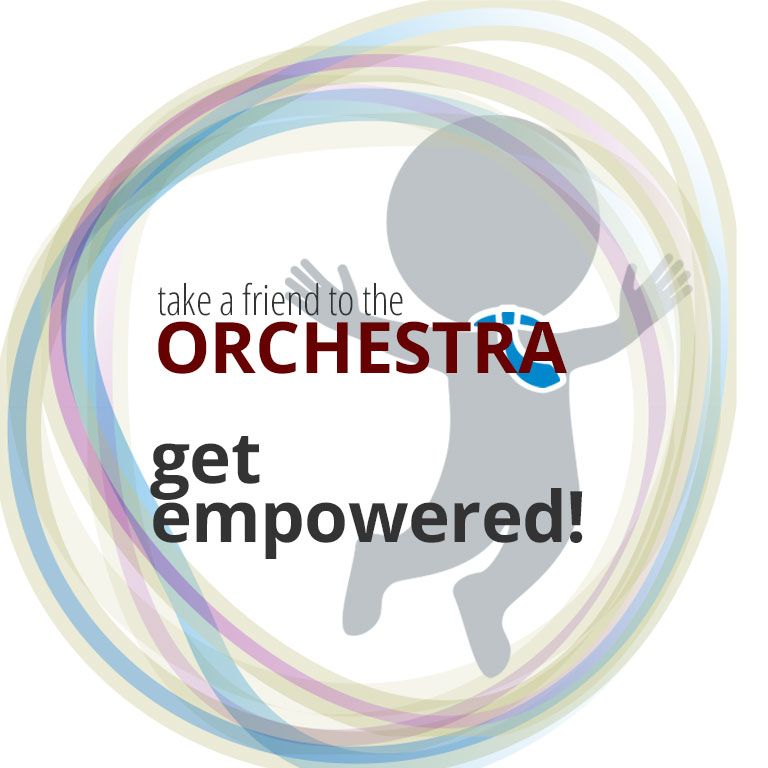To round out our TAFTO 2006 contributions I thought it would be appropriate to do something out of the ordinary. As such, our final contributor is providing a two part installment. Part 1 will cover the details behind his organizing a TAFTO event to an orchestra which is the only American ensemble than can rightfully claim to be an island unto itself: The Honolulu Symphony.
The guide for this journey is none other than Joe Patti, the entrepreneurially minded arts manager and author of Butts in Seats, his weblog on arts management. Joe’s unique contributions not only demonstrate the depth of his creativity but they also provide you with a detailed template on the entire thought process behind organizing your own TAFTO event.
However, I feel that one of the most important features in Joe’s contribution today isn’t directed toward patrons at all, instead, it’s best read by orchestra managers. So snap to attention orchestra managers and read Joe’s contribution, I guarantee you’ll be better off having done so…
TAFTO 2006 Contribution
By: Joe Patti
While I do work as a theatre manager, up until I took myself to the orchestra last year as part of Drew’s inaugural TAFTO challenge, my only real exposure to classical music was recognizing pieces from Bugs Bunny cartoons and a hazy recollection of attending a performance by the Albany (NY) Symphony Orchestra about 20 years ago. I don’t quite remember why I attended all those years ago. Though since I was a dorky college freshman I suspect an attractive woman and a free ticket were involved.
Since I had braved the orchestra alone last year and didn’t severely embarrass myself, this time I decided to be ambitious and take friends. After some discussion with Drew, I agreed to write an article touching on some concepts he suggested and then would follow up with a report on our attendance for a later installment. Little did I realize that the process of trying to take some friends to a performance would lend itself so well to an article all by itself.
I was honored by Drew’s request that I write something for Take A Friend to The Orchestra Month, especially after seeing who else would be contributing. It appeared I was the only contributor not involved with classical music in some degree so I felt I could offer some advice from the viewpoint of a person who is generally ignorant about classical music. Ultimately I think my experience to date is both a source of advice to fledgling TAFTO hosts and to symphonies for providing better access and interactions.
Like so many other classical music groups, the Honolulu Symphony presented a Mozart program this year to celebrate the composer’s 250th birthday. This was a perfect event in my eyes. Not only did it occur during Take Your Friend.. month, but the general awareness of Mozart by people without direct classical music experiences makes the program less intimidating to new attendees. What was even more attractive was that the program included Mozart’s Requiem, a piece to which the movie Amadeus lent a sinister air by suggesting the composer’s envious rival commissioned the work as part of a plan to kill Mozart. I figured this little bit of sexy trivia made the show more attractive to novices. I also thought the singing would help alleviate any anxiety a new person, (myself included), might feel about having to concentrate solely on unfamiliar music and offer an opinion.
I wrote up my pitch alluding to many of these elements and assuring people that as a novice myself, the conversation would be pretense free. I emailed it out to all the faculty and staff on the college campus at which I work giving an RSVP date a week before the concert. While I waited for responses, I contacted the Education Department at the Honolulu Symphony and asked if there were any materials about the Mozart program because I, along with others in my group, were novice attendees and wanted to prepare ourselves for the event.
Because I am essentially an inexperienced classical music patron who wouldn’t know what to do or who to call if he wasn’t in the arts, I tried to fully simulate a true newbie’s experience by only working with the information I could glean from the symphony’s website. For this reason, I left my home number rather than my work number and didn’t identify myself as an arts professional. This interaction ended up being rather disappointing because after calling 17 days and 11 days in advance of the performance, I have yet to hear back from these folks.
I actually met and spoke with the Symphony Marketing V.P. once and am generally acquainted with a couple musicians so I might have been able to get them to intercede on my behalf or provide me with the materials themselves. The general member of the community hoping to prepare himself and his friends would most likely feel a little frustrated. From the Education Department’s voice mailbox, I get the impression that the staff may only be part time. I can understand why that would be with funding being tight. The only reason I am be able to offer any type of support material to my audiences is because my assistant theatre manager is excellent at pulling interesting stuff together. I would expect even with a part time staff though, that someone from the symphony would check the voice mail once a week.
As I waited for the RSVP date to arrive, I had some interesting interactions around campus. First of all, one of the people who responded said she used to attend the Detroit Symphony Orchestra pretty much on a monthly basis, but hadn’t attended the local symphony since she moved to Hawaii. So if nothing else, the TAFTO program is getting a person who is likely to regularly attend into a local symphony’s hall. Another responder said she had never attended and was going to try it out for a first time.
I was stopping by the Human Resource office and one of the clerks who had seen my email told me that while she couldn’t make it on that date, she regularly attended the symphony. I hadn’t really pegged her as liking classical music. This is a lesson for would-be TAFTO hosts. Don’t be afraid to put yourself out there and invite strangers and those appearing to be unlikely prospects. You might discover that they are quite ready, willing and perhaps even more able than you.
One thing the clerk counseled me was to beware of a program change. She said that she purchased tickets for a program by one composer only to end up with an evening of Wagner. She didn’t know why the program had changed. Perhaps it happens all the time. As an inexperienced attendee who has no idea if this is a regular practice, I was concerned that I might be inviting people to a performance that was less appealing to first time patrons than I anticipated. Heck, if that had happened to me the first time I attended the symphony, I might be so anxious I would never go back. On further consideration, I decided the program was unlikely to change that significantly since the event was so prominently centered on a theme.
By the RSVP date I had five people interested in attending the performance. This was fine with me. I didn’t relish leading too large a group on my first outing. At the time, there was a little more information about the performance available from the orchestra in the form of an online press release. It had information on the various legends of the mysterious person who commissioned The Requiem and on the choral groups participating in the performance so I was able to offer some background information to my group in advance of our visit.
There was a little snag in my plans though. Apparently quite a number of people were of the same opinion as I about how great it would be to attend the performance. When we tried to order seats online at Ticketmaster on Monday, I discovered that all the $46, $35 and $12 tickets for the performance on the following Sunday were gone. There were, however, plenty of $65 tickets. I think it is pretty clear what range the symphony should be pricing most of their tickets in. It is also a lesson to TAFTO organizers to set RSVP dates for popular programs a little earlier! Of course as an infrequent attendee, I was ignorant of the potential sell out. The $65 price was an impediment to attendance for all of us. One of the people emailed me and outright said the experience wasn’t worth that much.
Hoping that there might be some tickets the symphony held back from online sale, I called the symphony box office. This was the next source of frustration for me. According to their website, the box office is open 9-5. I called and ended up leaving messages three days in a row. The only return call I received was at 7:30 pm. However, it was at my office number since that was where I expected to be between 9-5.
My honor as the host was on the line now so I put away the pretense of being Joe Everyman and emailed and called the marketing director. I explained what TAFTO was all about and asked if she could help out by getting me access to lower priced tickets. I didn’t ask for comps, not only because 5 free tickets is a little too much to be asking for, but also because I believe that if you are going to introduce a friend to any of the arts for the first time with the intent of making a recurring practice, they should be in the mindset of paying and valuing the experience from the start.
Giving out free samples of chicken nuggets in the grocery store makes sense. People are comfortable with chicken and making decisions about it. Arts attendance is another matter. If a person has to pay even a token $5 to attend a $30 event with a friend, they will probably feel the experience imparted enough expertise to make a decision to pay $5 later by themselves. If they don’t have to pay anything today, I worry that parting with even $5 later might be the cause of extended internal debate.
I mentioned something similar in my email to the marketing director and she agreed with my thinking. At first she proposed student rush tickets on the day, but upon learning that none of us were students, suggested providing comps in return for a donation. While I was trying to make arrangements with the marketing director, I made contact with an orchestra musician friend of Drew’s who said he might be able to arrange for tickets if I was unable to get any from the marketing director. (I have come to the realization that Drew knows far too many people in far too many places for me to be safe if I get on his bad side!)
If nothing else, this experience serves to show my other group members that there are people with budget constraints similar to their own who are excited about attending the symphony and that can’t be all bad. I haven’t told them about the difficulties I have faced. That is pretty much counter to the intent of the whole TAFTO exercise. Out of respect for the symphony, I let them know about my frustrating experiences so they wouldn’t first learn of them on Adaptistration.
Stay tuned for my next installment when I discuss what happened at the symphony!



Nice! Joe’s comments make a great pilgrim’s progress story, complete with detours and pitfalls for the single ticket buyer. Take calling the education department with a request for info about the upcoming concert…
How’s a first-time attender supposed to know that a symphony’s education department is probably in charge of school and community outreach, rather than subscription series material? You’d need to call someone in marketing or public relations to get readily available information about the concert. (At that, you might still receive exactly what’s already posted on-line, or printed in the season brochure.)
As for why Joe never received a return call: what if the education department never informed the marketing department that he had called with questions about the concert?
In St. Louis, the St. Louis Symphony has a “50 Free Ticket” program where the SLSO sets aside for most subscription concerts 50 free tickets for the community. One signs up for a punch card that allows for 6 of these tickets in a season per person. The tickets are given out 90 minutes before concert time, first come, first served.
I’ve taken advantage of this program and have gotten friends to do so. It’s especially useful for those of limited means, in the spirit of the above posting. Ideally, it would be only people with an interest in the Symphony, but of limited means, who would make use of this program. In practice, of course, people of any economic background, myself included, partake of this system. This is, perhaps, why it is limited to 6 concerts per person per season. (I should say also that I do have a regular paid-up subscription in addition to getting a punchcard in a given season.)
The line can be variable. Some times, the Symphony can’t give the seats away, with only about 10 people in a line on a given night. This is usually the case where neither the conductor nor the guest soloist is a “big name”. When the SLSO Chorus is featured, however, or if the Saturday night concert is the only one that weekend, then the line can snake through the lobby and easily break 50.
With the Philadelphia Orchestra, the orchestra offers $10 tickets the night of the concert, starting at 5:30 PM. Usually the tickets that are sold, from what I’ve heard, are single seats scattered about the hall that the box office tries to “plug the gaps” with these sales. The last time I was there and stood on line, the crowd to get these tickets looked like at least 50 or so.